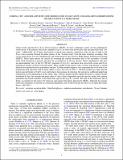CORONA, JET, AND RELATIVISTIC LINE MODELS FOR SUZAKU/RXTE/CHANDRA-HETG OBSERVATIONS OF THE CYGNUS X-1 HARD STATE
Author(s)
Nowak, Michael A.; Hanke, Manfred; Markoff, Sera B.; Wilms, Jörn; Pottschmidt, Katja; Coppi, Paolo; Maitra, Dipankar; Davis, John E.; Tramper, Frank; Heine, Sarah N.T.; ... Show more Show less
DownloadNowak-2011-CORONA, JET, AND REL.pdf (3.583Mb)
PUBLISHER_POLICY
Publisher Policy
Article is made available in accordance with the publisher's policy and may be subject to US copyright law. Please refer to the publisher's site for terms of use.
Terms of use
Metadata
Show full item recordAbstract
Using Suzaku and the Rossi X-ray Timing Explorer (RXTE), we have conducted a series of four simultaneous observations of the galactic black hole candidate Cyg X-1 in what were historically faint and spectrally hard "low states." Additionally, all of these observations occurred near superior conjunction with our line of sight to the X-ray source passing through the dense phases of the "focused wind" from the mass donating secondary. One of our observations was also simultaneous with observations by the Chandra-High Energy Transmission Grating (HETG). These latter spectra are crucial for revealing the ionized absorption due to the secondary's focused wind. Such absorption is present and must be accounted for in all four spectra. These simultaneous data give an unprecedented view of the 0.8-300 keV spectrum of Cyg X-1, and hence bear upon both corona and X-ray emitting jet models of black hole hard states. Three models fit the spectra well: coronae with thermal or mixed thermal/non-thermal electron populations and jets. All three models require a soft component that we fit with a low temperature disk spectrum with an inner radius of only a few tens of GM/c[superscript 2]. All three models also agree that the known spectral break at 10 keV is not solely due to the presence of reflection, but each gives a different underlying explanation for the augmentation of this break. Thus, whereas all three models require that there is a relativistically broadened Fe line, the strength and inner radius of such a line is dependent upon the specific model, thus making premature line-based estimates of the black hole spin in the Cyg X-1 system. We look at the relativistic line in detail, accounting for the narrow Fe emission and ionized absorption detected by HETG. Although the specific relativistic parameters of the line are continuum dependent, none of the broad line fits allow for an inner disk radius that is >40 GM/c [superscript 2].
Date issued
2011-02Department
MIT Kavli Institute for Astrophysics and Space ResearchJournal
Astrophysical Journal
Publisher
Institute of Physics/American Astronomical Society
Citation
Nowak, Michael A., Manfred Hanke, Sarah N. Trowbridge, Sera B. Markoff, Jörn Wilms, Katja Pottschmidt, Paolo Coppi, Dipankar Maitra, John E. Davis, and Frank Tramper. “ CORONA, JET, AND RELATIVISTIC LINE MODELS FOR SUZAKU / RXTE / CHANDRA -HETG OBSERVATIONS OF THE CYGNUS X-1 HARD STATE .” The Astrophysical Journal 728, no. 1 (January 14, 2011): 13. © 2011 American Astronomical Society.
Version: Final published version
ISSN
0004-637X
1538-4357